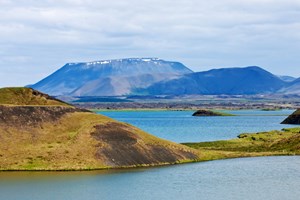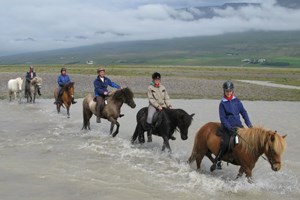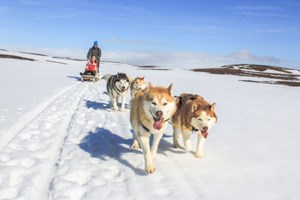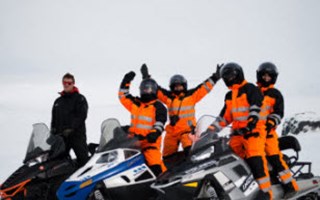A Visit to Súðavík Village and Langeyri in the Westfjords of Iceland
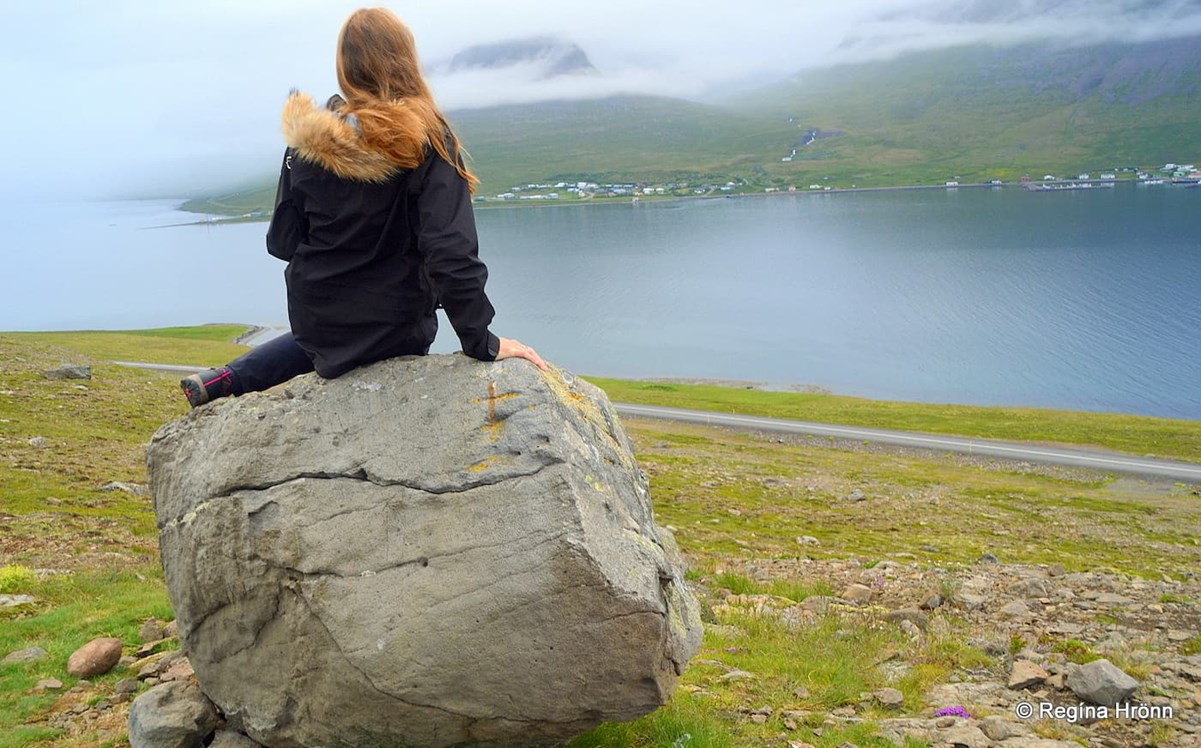
Sometimes one just has to be the Little Mermaid ;) The Mermaid rock at Kambsnes
This travel-blog is a part of my series of travel-blogs about the northern part of the Westfjords of Iceland.
We are driving along road 61 (Djúpvegur) coming from visiting the cute seals at Hvítanes.
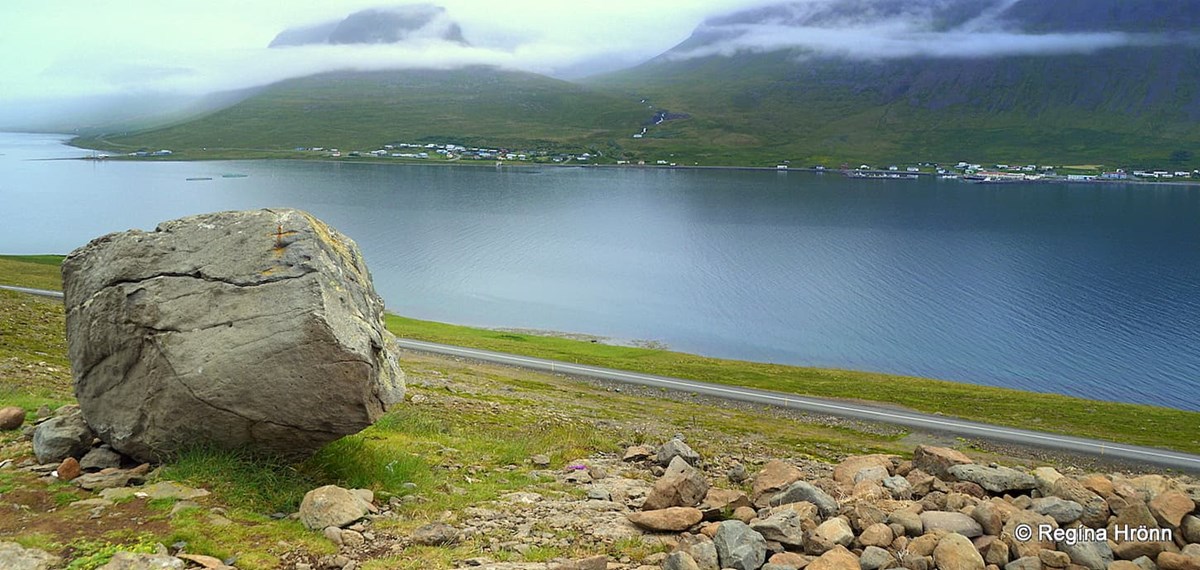
Kambsnes view-point
In my last 4 travel-blogs about the northern part of the Westfjords of Iceland, we have driven through Ísafjörður, Vatnsfjörður, Mjóifjörður, and Skötufjörður fjords.
Now we are driving through Hestfjörður and Seyðisfjörður and will be staying for the night in Álftafjörður fjord.
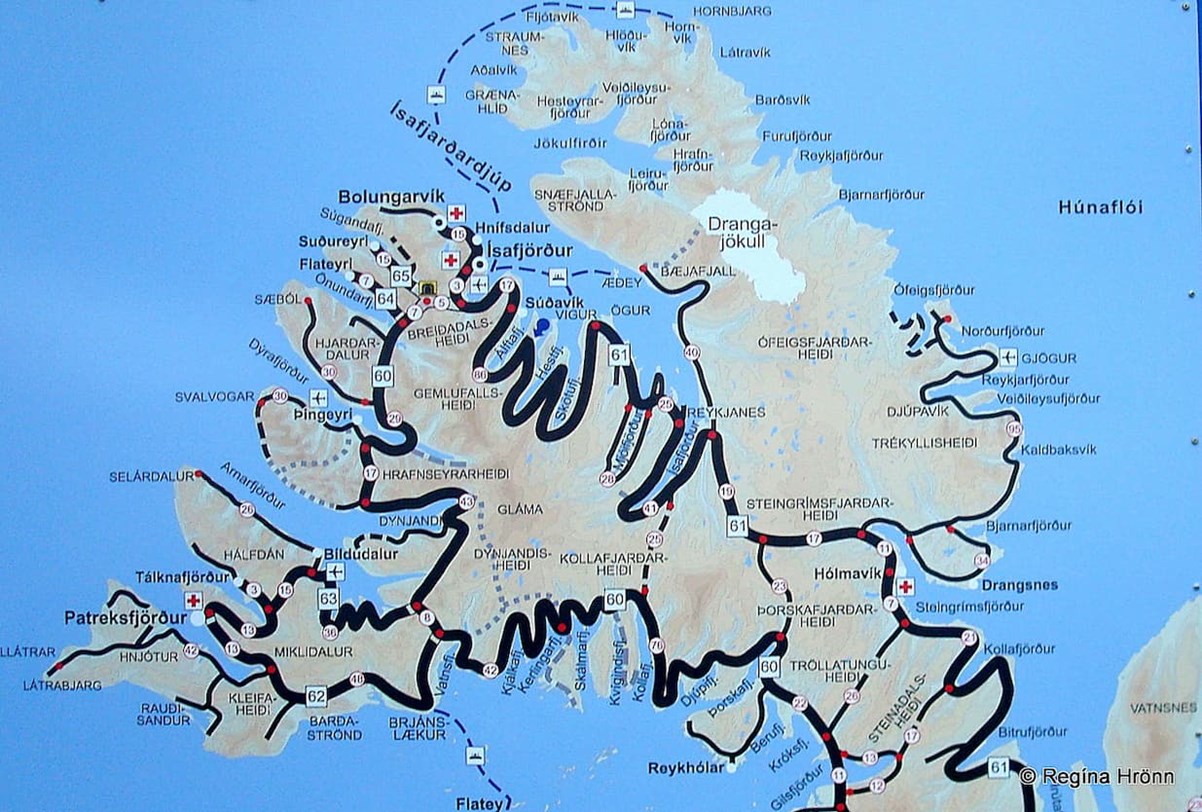
A map of the Westfjords
If you know your way around Iceland then you will notice that some of the fjords in Iceland have the same name. There is f.ex. a much better known Seyðisfjörður in East-Iceland.
Kambsnes panoramic view-point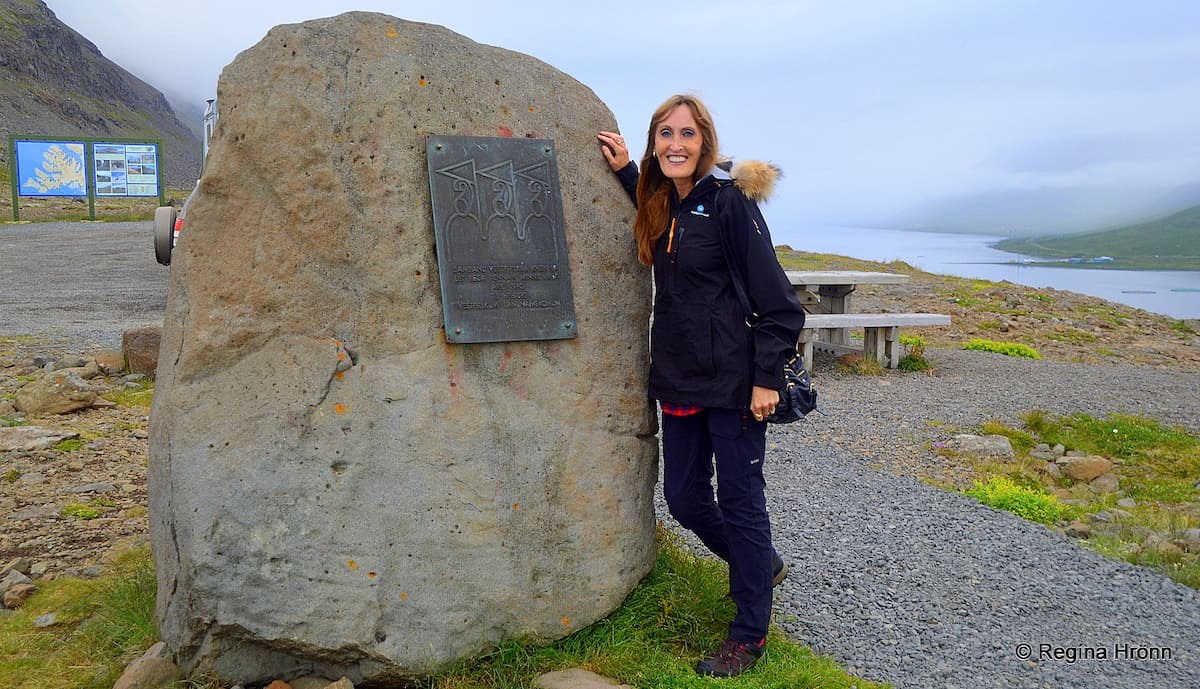
The memorial stone at Kambsnes
At Kambsnes peninsula which divides Seyðisfjörður and Álftafjörður fjords, you will find an excellent panoramic view-point with maps, a picnic area, a view-dial, and a memorial stone.
On the plaque of the stone is written: "Samband vestfirskra kvenna lét reisa þennan minnisvarða árið 1980 til heiðurs vestfirskum landnámskonum".
Which translated into English means: "The Union of Women from the Westfjords, erected this monument (memorial stone) in the year 1980 in honour of the settler women who settled the Westfjords". 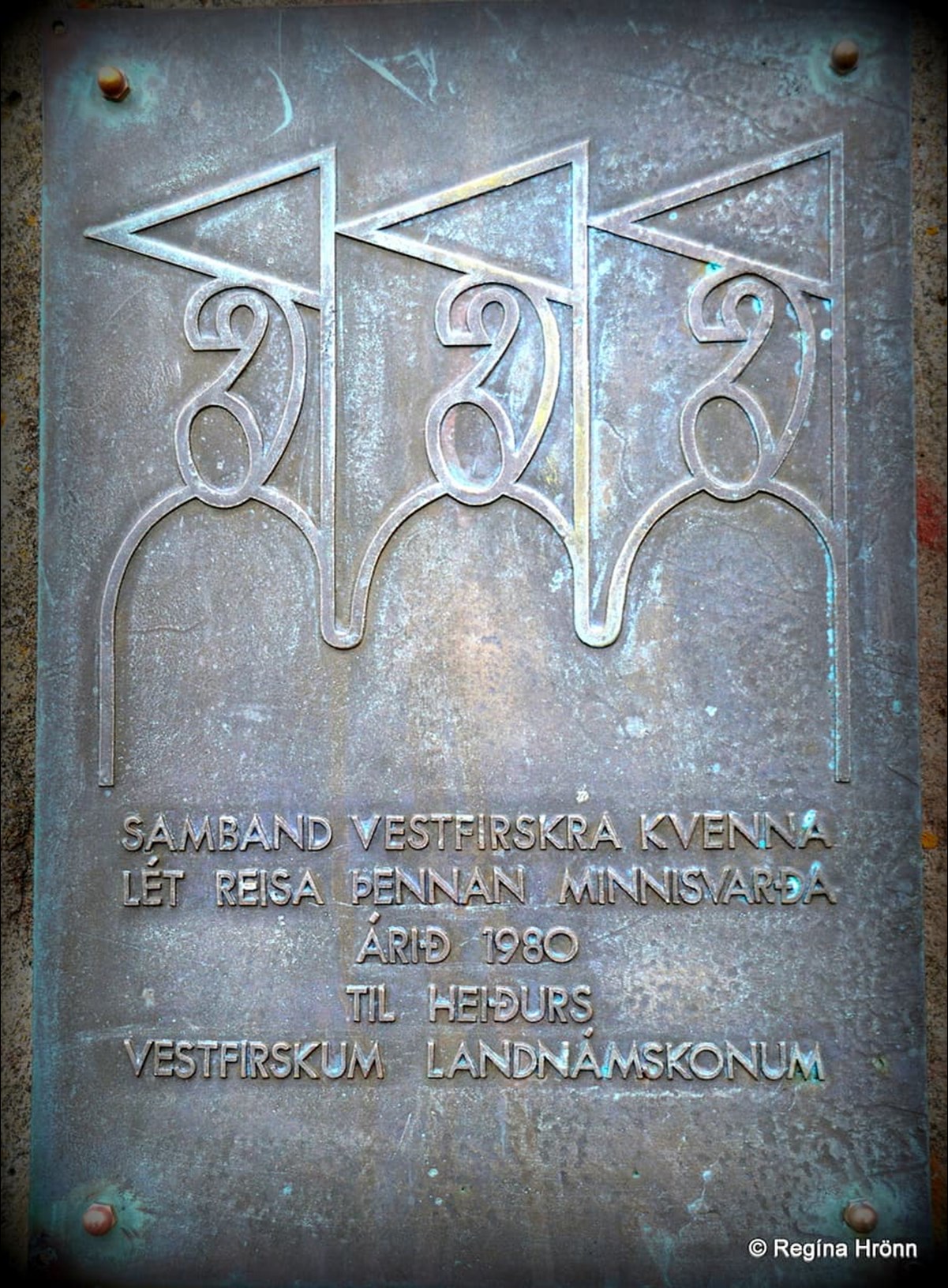
The memorial plaque for the settler women of the Westfjords
Here you will also find what I like to call "Hafmeyjusteinninn" - the Mermaid Rock, from which there is an excellent view of Álftafjörður fjord and Súðavík village.
And a great photo opportunity if you want to imitate the Little Mermaid in Copenhagen - see my opening photo ;)
Dvergasteinn - the Dwarf Rock in Álftafjörður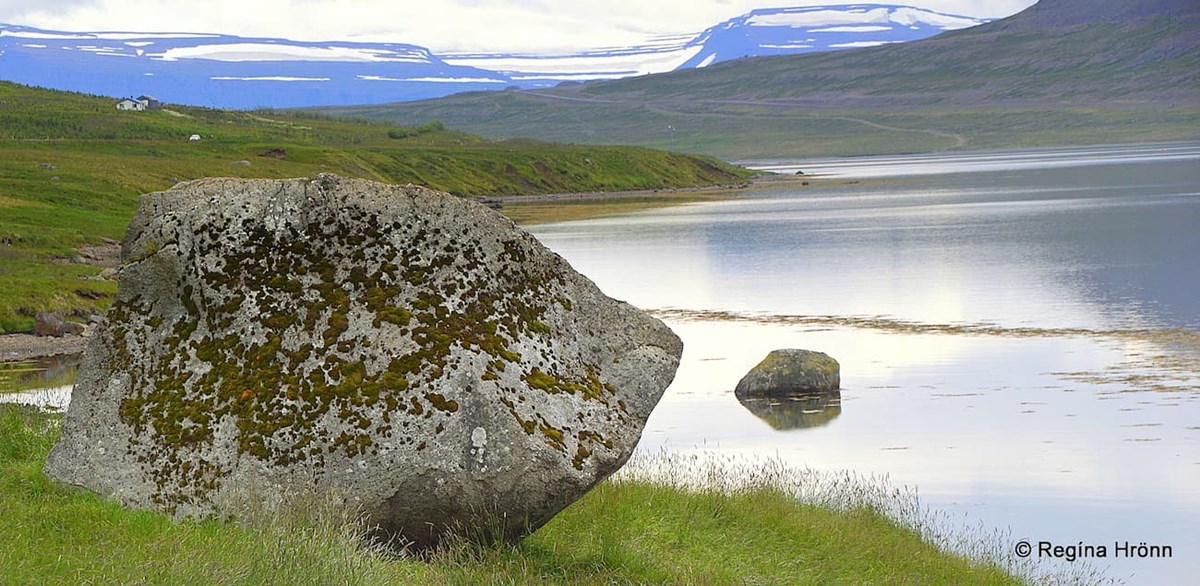
Dvergasteinn rock
When driving in Álftafjörður fjord you will notice another rock and a sign by one of the farms "Dvergasteinn" or the Dwarf Rock. Here is a rock that is said to be the house of the dwarfs!
The story goes that the inhabitants of Álftafjörður were well aware of the family of dwarfs in this rock. And they protected the habitation of the dwarfs and no racket was allowed by the rock, much as is the Icelandic tradition by the habitation of the elves - the hidden people of Iceland.
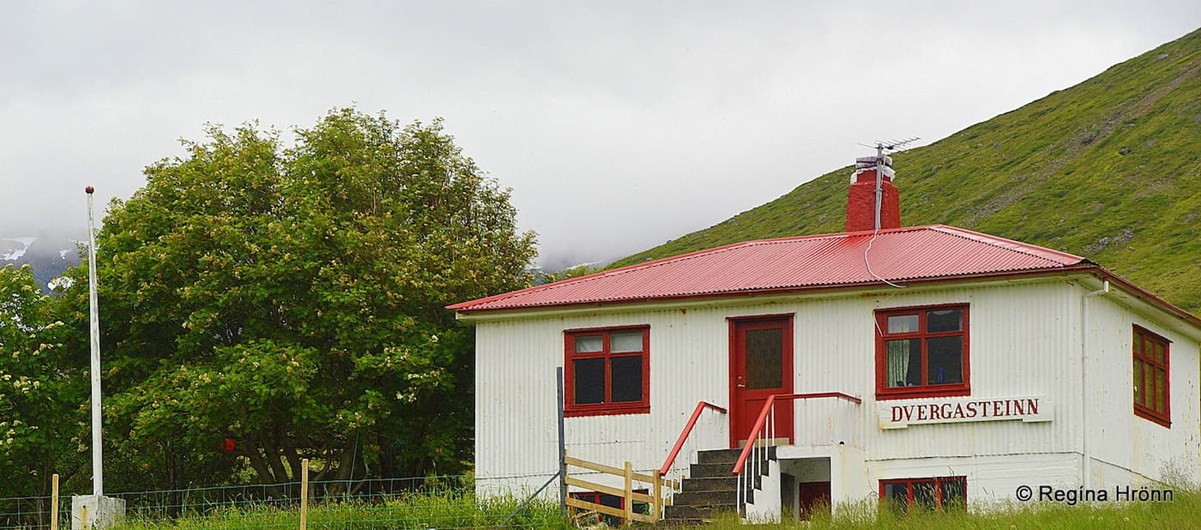
Dvergasteinn farm
Some of the farmers' wives put a hearty meal by the rock at the ingathering at Christmas, and on the Epiphany.
They said these words: "Geri sér að góðu þeir, sem í steini búa! Viljum við með vinsemd vættir góðar hylla!" meaning: "Bon appétit to you who reside in this rock! We want, with gratitude, to pay homage to you gracious powers!".
One farmer's wife didn't respect the sanctity of the rock and it was revenged, she got a bad eye ache and saw the errors of her way. Ref. Sagnagrunnur.
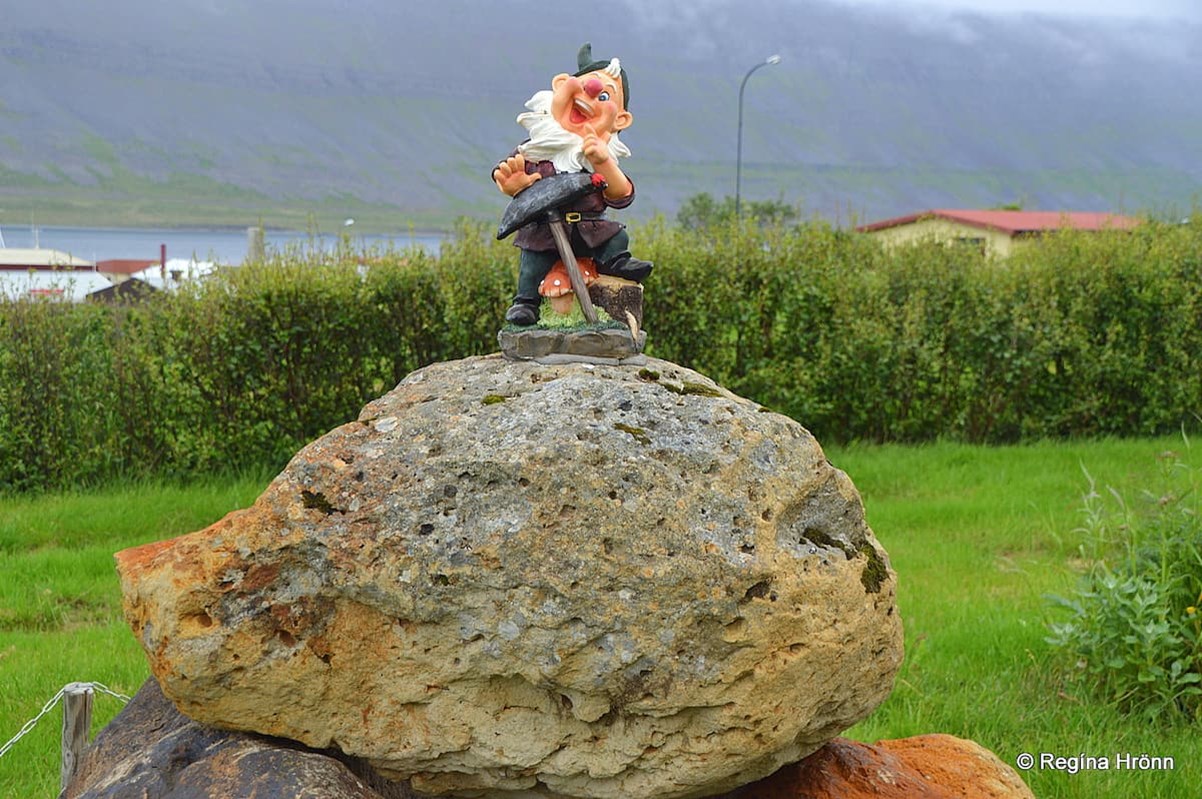
A replica of the dwarf rock in Raggagarður family park at Súðavík village
There is another story of a dwarf living in Mt. Bardagi. This dwarf had an argument with the farmer on the other side of Álftafjörður fjord.
The dwarf wanted revenge and threw 3 big rocks across the fjord at the farm. None of the 3 rocks hit the farm. In my photos, you can see 2 of these rocks.
In another account, there were 2 dwarfs on each side of the fjord who were battling and one dwarf threw the stones across the fjord at the other dwarf (Ref. page 32 in the essay of Davíð Pétur Steinsson).
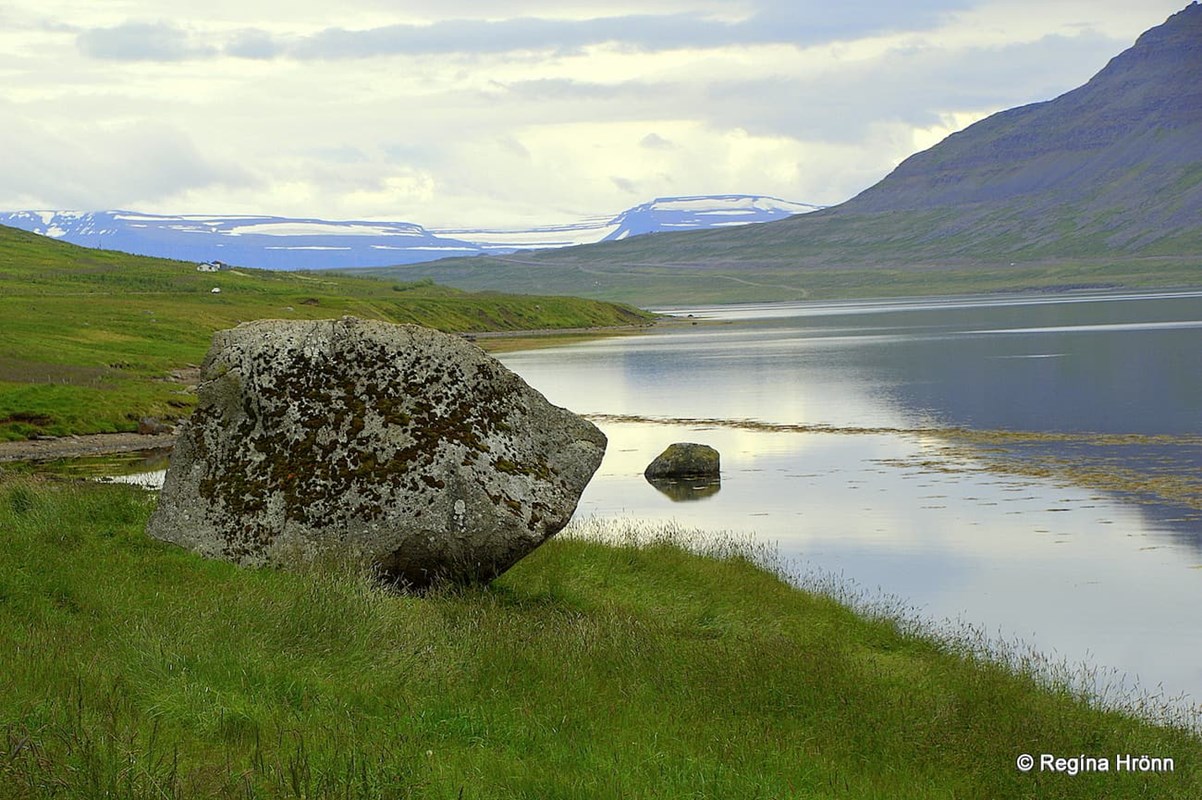
Dvergasteinn rock
There are many stories about the hidden people of Iceland in our folklore, but stories about dwarfs in Iceland are much rarer, so I found it amazing to see these dwarf rocks here in Álftafjörður.
I have written another travel-blog about a dwarf rock in East Iceland if you want to know more about the Icelandic dwarfs:
Dvergasteinn - the Rock of the Dwarfs - by Seyðisfjörður in East-Iceland - Icelandic Folklore
Súðavík village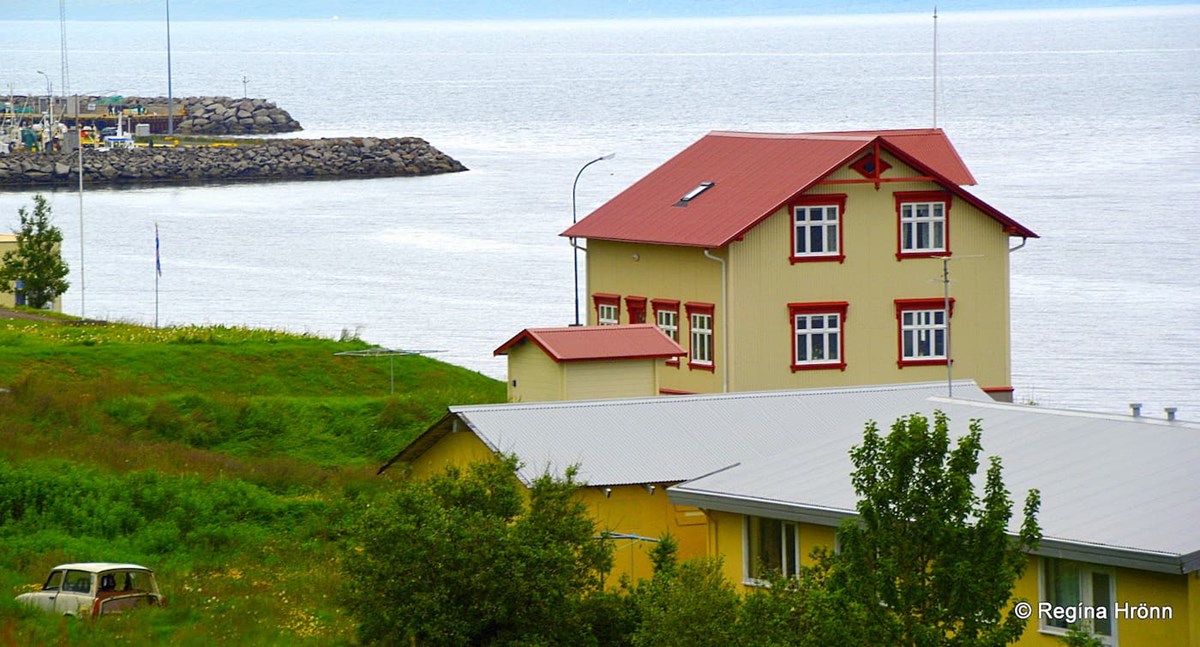
Súðavík village
Súðavík village is our next stop, a small hamlet with a population of 175 (in 2020). This is the first village we encounter on this long route since we left Hólmavík village.
Súðavík village is thus the service hub for the farmers in Ísafjarðardjúp. And they produce their own chocolate at Sætt og salt ehf, which includes sea salt from this area.
You will notice a colourful phone booth when you enter the old village. This is Litla skiptibókasafnið or the Little Book Exchange Library - very cute :)
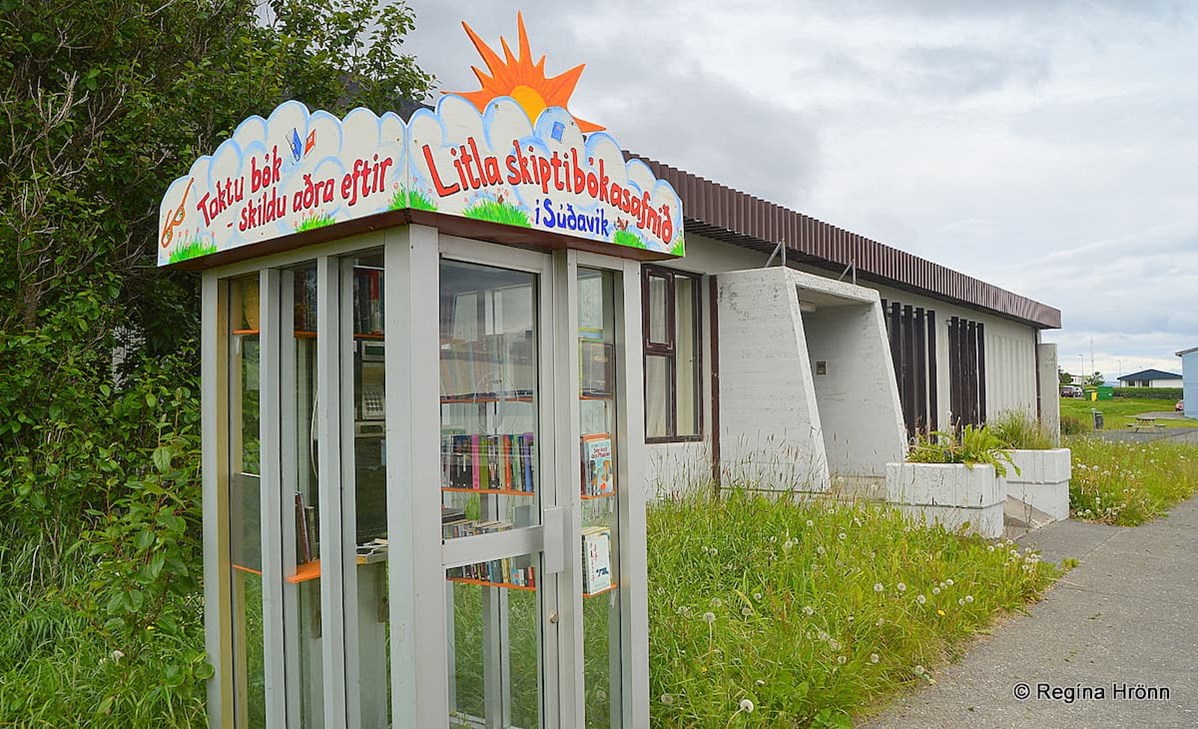
The Book Exchange Library in Súðavík
The Book Exchange Library is in the last still functioning phone booth in Iceland. The phone is still connected and accepts coins (ISK 10).
Dagbjört Hjaltadóttir, a primary school teacher in Súðavíkurskóli school, came up with this lovely idea and she is the one who made the colourful sign and maintains the little library.
Dagbjört is an avid reader and owns a lot of books, so many of the books in the library are hers.
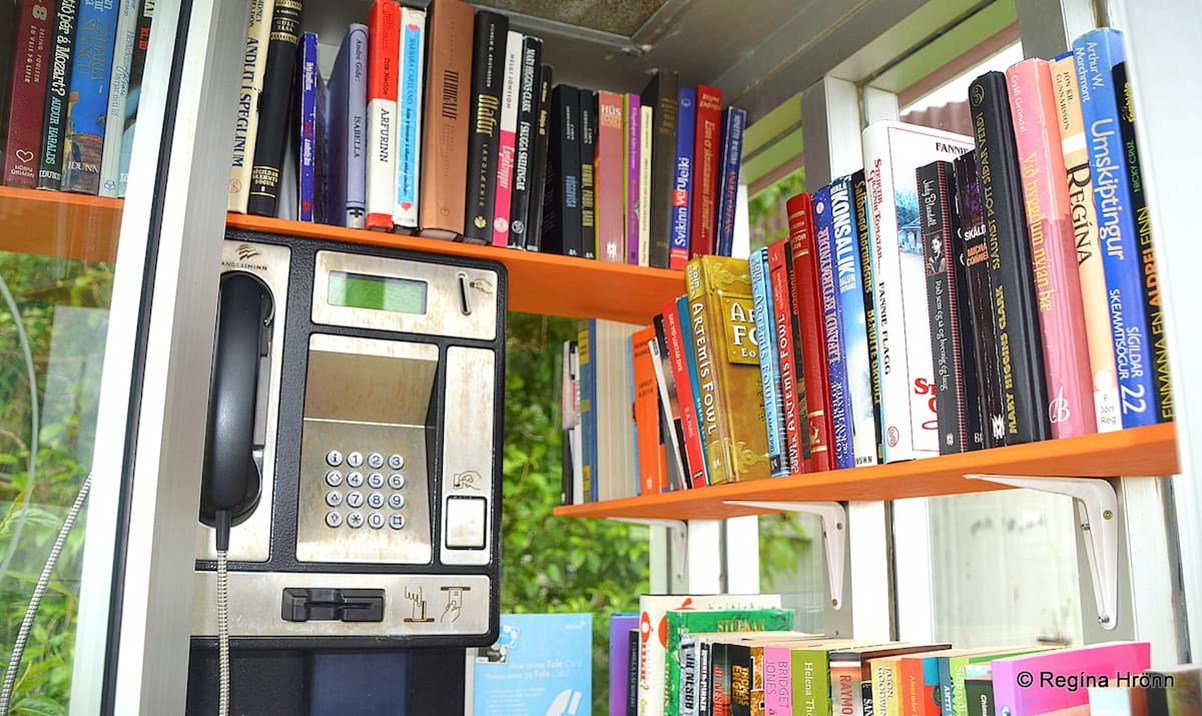
The Book Exchange Library at Súðavík - do you notice the name of one of the books ;)
Dagbjört is a prankster and sometimes startles people by dialing the phone number of the booth while people are selecting books (Mbl.is) :)
Melrakkasetur - The Arctic Fox Centre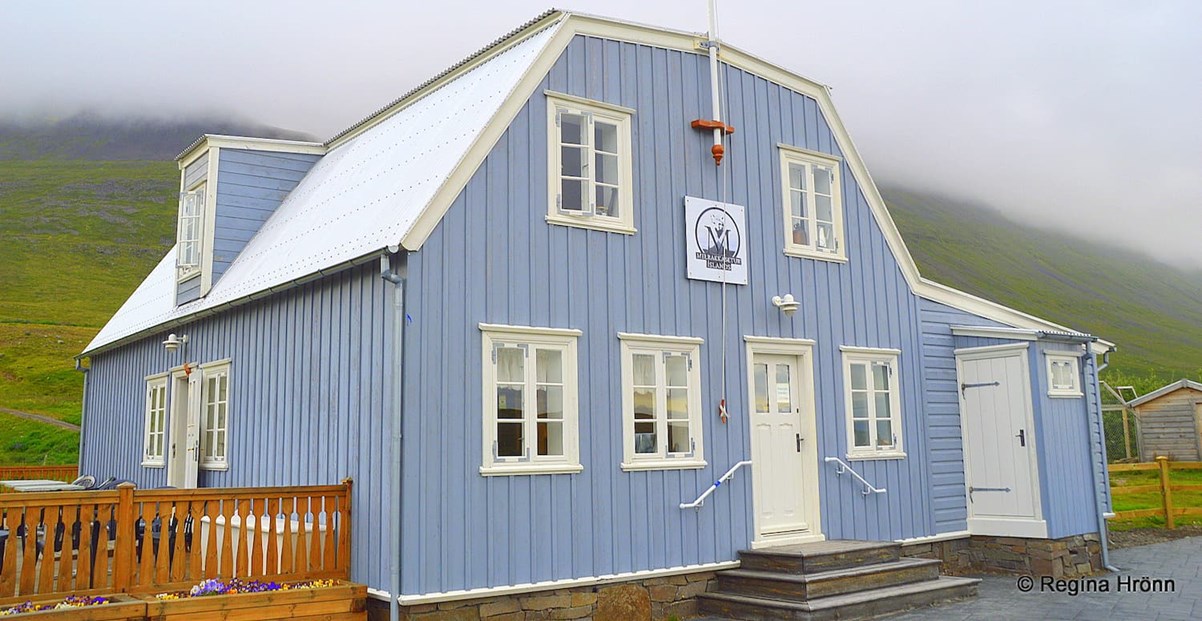
Melrakkasetur - the Arctic Fox Centre
Every village and town in Iceland has got a museum. A prominent building in Súðavík village is the lovely blue-painted Melrakkasetur - the Arctic Fox Centre exhibition and research centre.
The Arctic Fox is the only terrestrial mammal native to Iceland, both loved and hated as it tends to kill our sheep.
The Arctic fox can be found all around Iceland, and I have seen it both at Strandir in the Westfjords region, close to Pétursey in South-Iceland and in the highland.
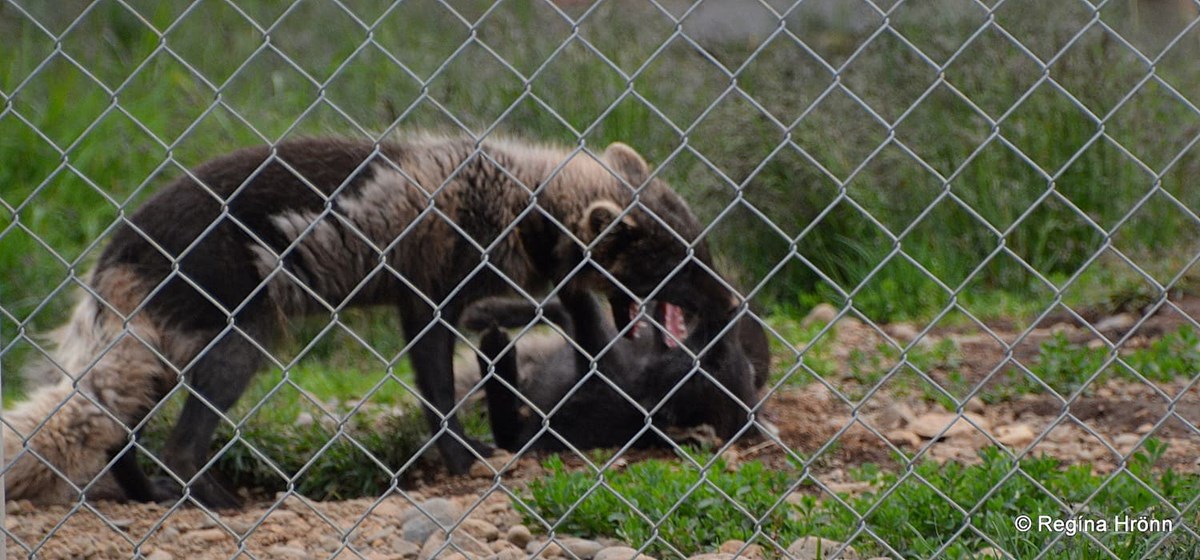
Arctic foxes by the Arctic Fox Centre in Súðavík
The Arctic fos is very afraid of humans and I have seen it jump high in the air when it noticed me.
The only place where it is not afraid is in its sanctuary in Hornstrandir Nature Reserve.
You can see live Arctic foxes fenced off outside by the Arctic Fox Centre.
Raggagarður - the Westfjord family park 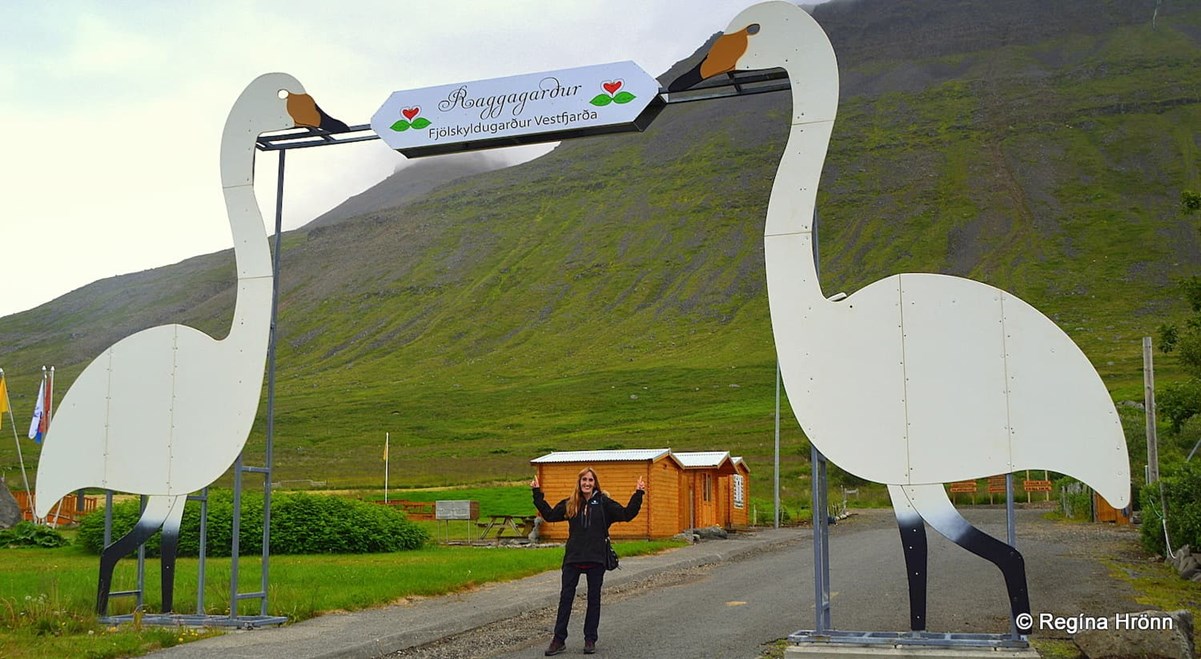
Raggagarður family park in Súðavík
The landmark of Súðavík village is Raggagarður - Fjölskyldugarður Vestfjarða, the Westfjord family park, and playground in the old part of Súðavík.
You cannot miss it as 2 big white swans guard the entrance to the park.
That is fitting as Súðavík is located in Álftafjörður fjord - the Swan fjord.
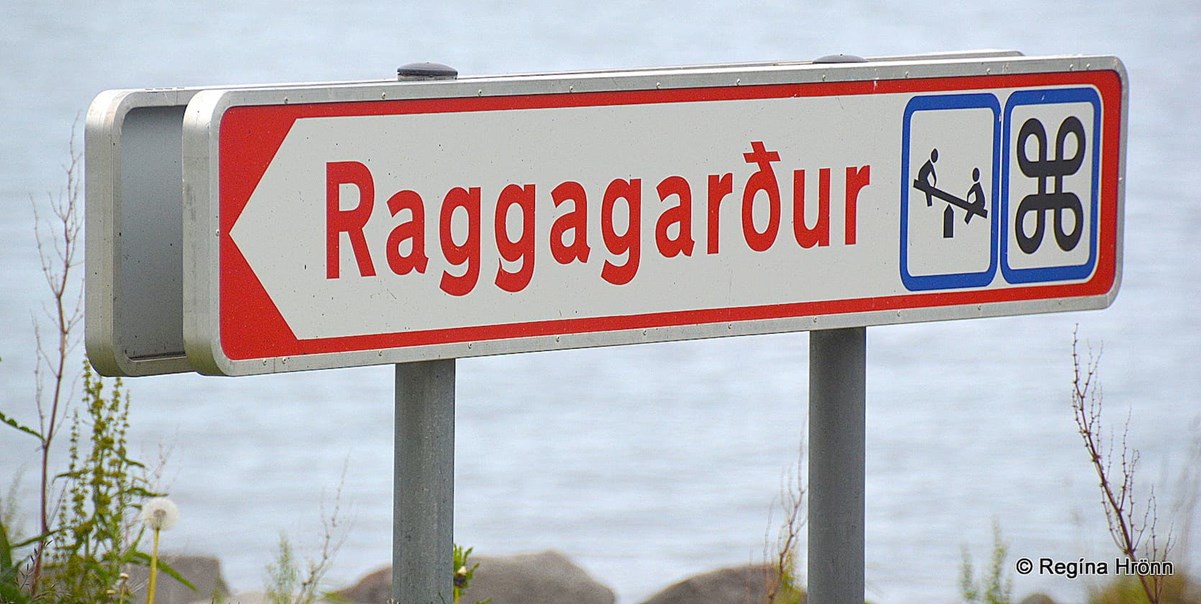
It is a lovely park, founded in the memory of Ragnar Frey Vestfjörð who tragically lost his life in a car accident on the 19th of August 2001 at Súðavík, only 17 years old.
His mother, Vilborg Arnarsdóttir, founded this lovely memorial park in the memory of her son, hoping that it would urge parents to spend more time with their children at the park and contemplate on what gives value to life.
Raggagarður was opened in 2005 and is open for guests during the summer months.
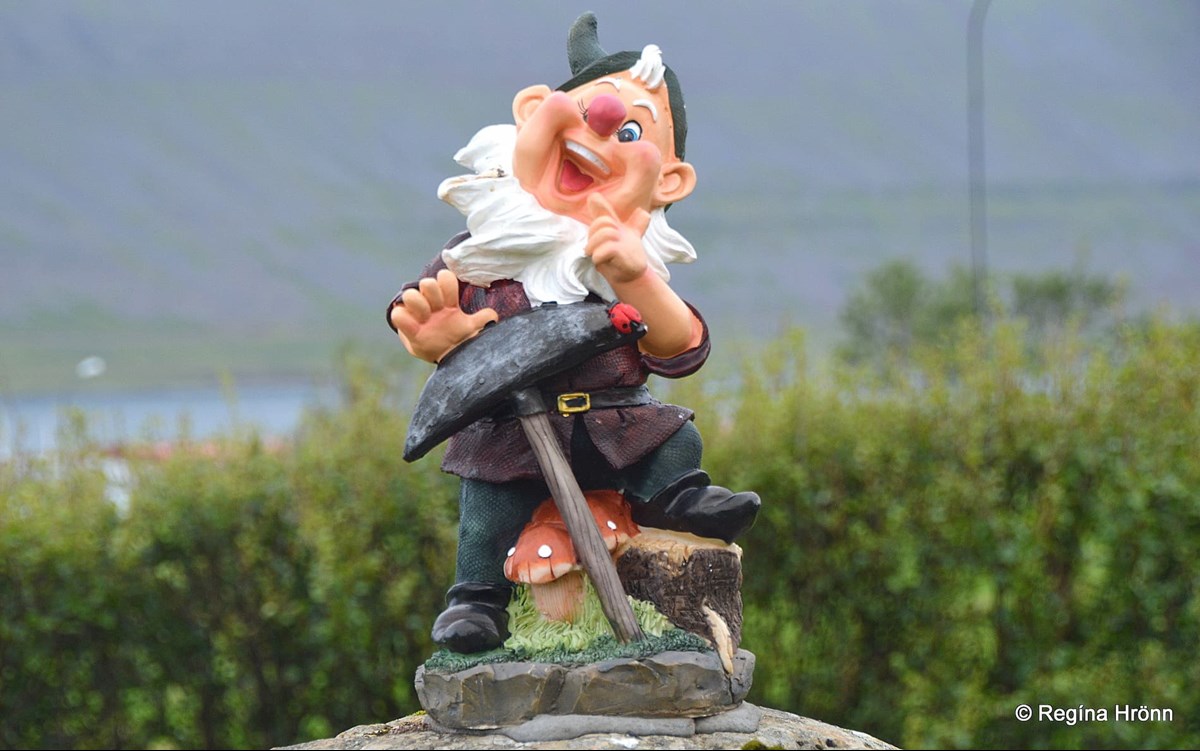
A dwarf on a rock at Raggagarður family park
Raggagarður is not only made for kids but also grown-ups who are kids at heart, so my husband and I went for the swings and tried out the playground equipment :)
On the website of Raggagarður park is written that the playground equipment is suitable for people of 8-99.
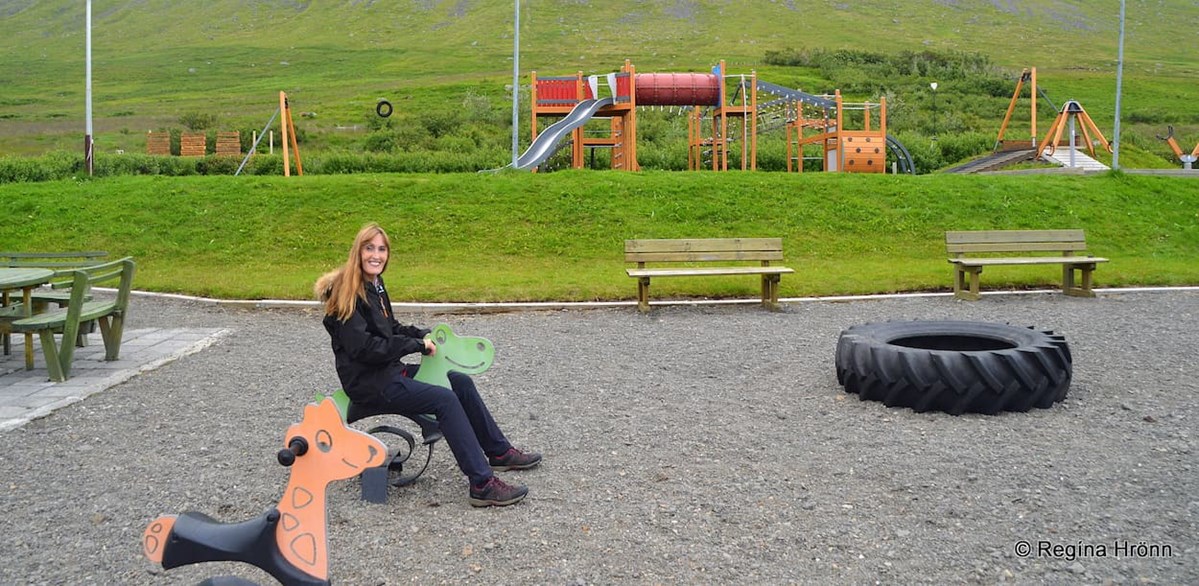
Trying out the playground equipment at Raggagarður park
There are chairs and tables for 130 people in Raggagarður - almost the whole population of the village and they welcome guests.
This is a big park for such a little village - kudos to them for a job well done.
Several people have donated their time and money to the construction of this lovely memorial park.
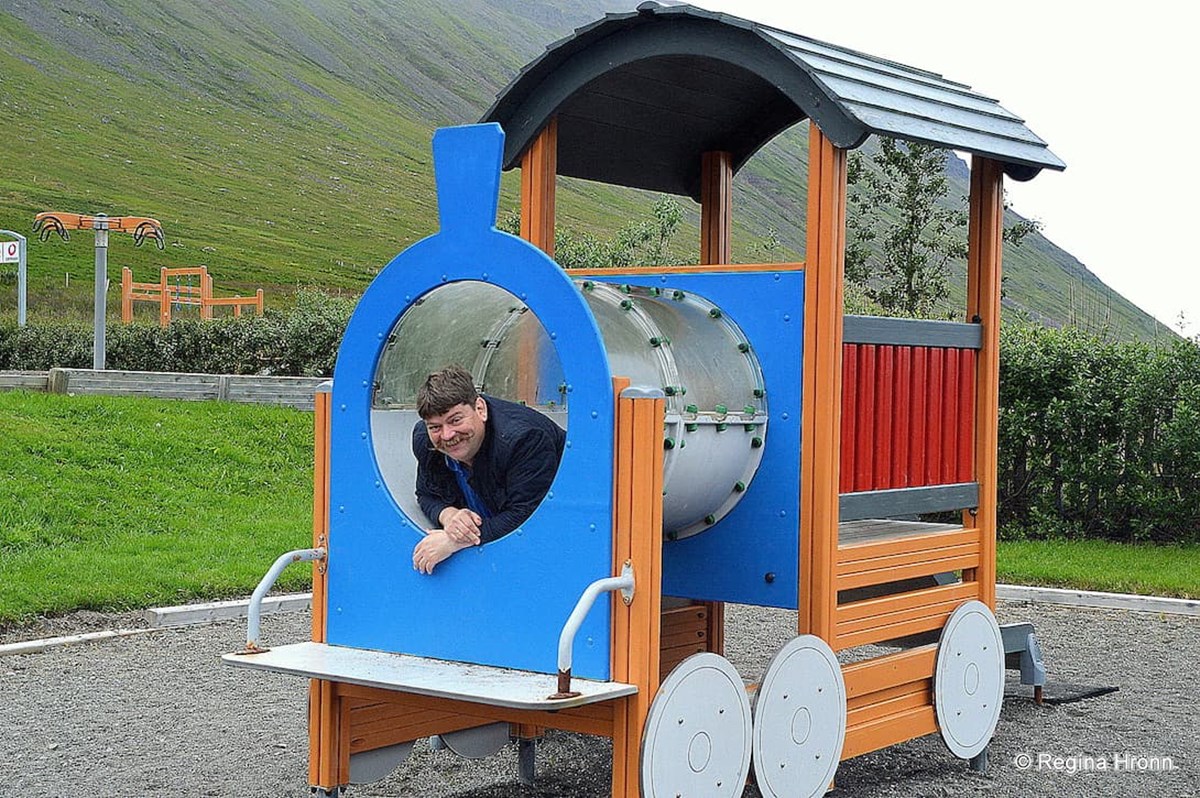
My husband in Raggagarður family park
Raggi is a nickname for Ragnar. A special part of Raggagarður is called Boggutún - but Bogga is the nickname of Vilborg.
Now (2021) Raggagarður also sports 7 statues so it is becoming more and more interesting to visit.
6 of the statues were made by Gerður Gunnarsdóttir and one by Jón Gunnar Árnason, called Blóm í glugga.
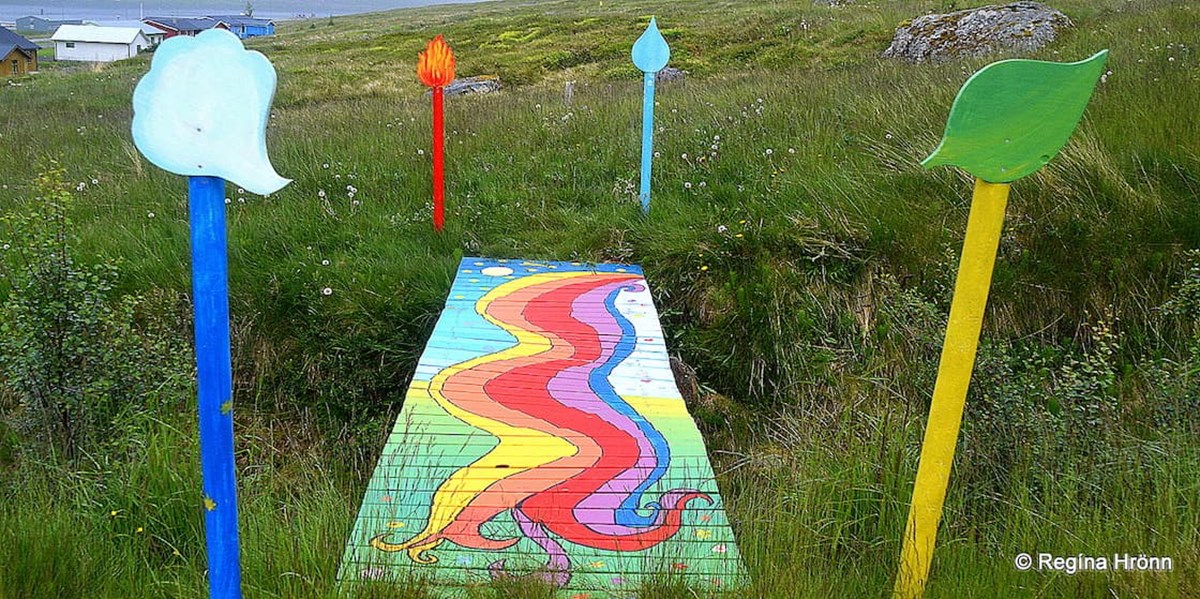
A colourful bridge in Raggagarður family park
The Raggagarður park is located by Nesvegur road.
You can see more photos on the Raggagarður website.
Avalanches in Súðavík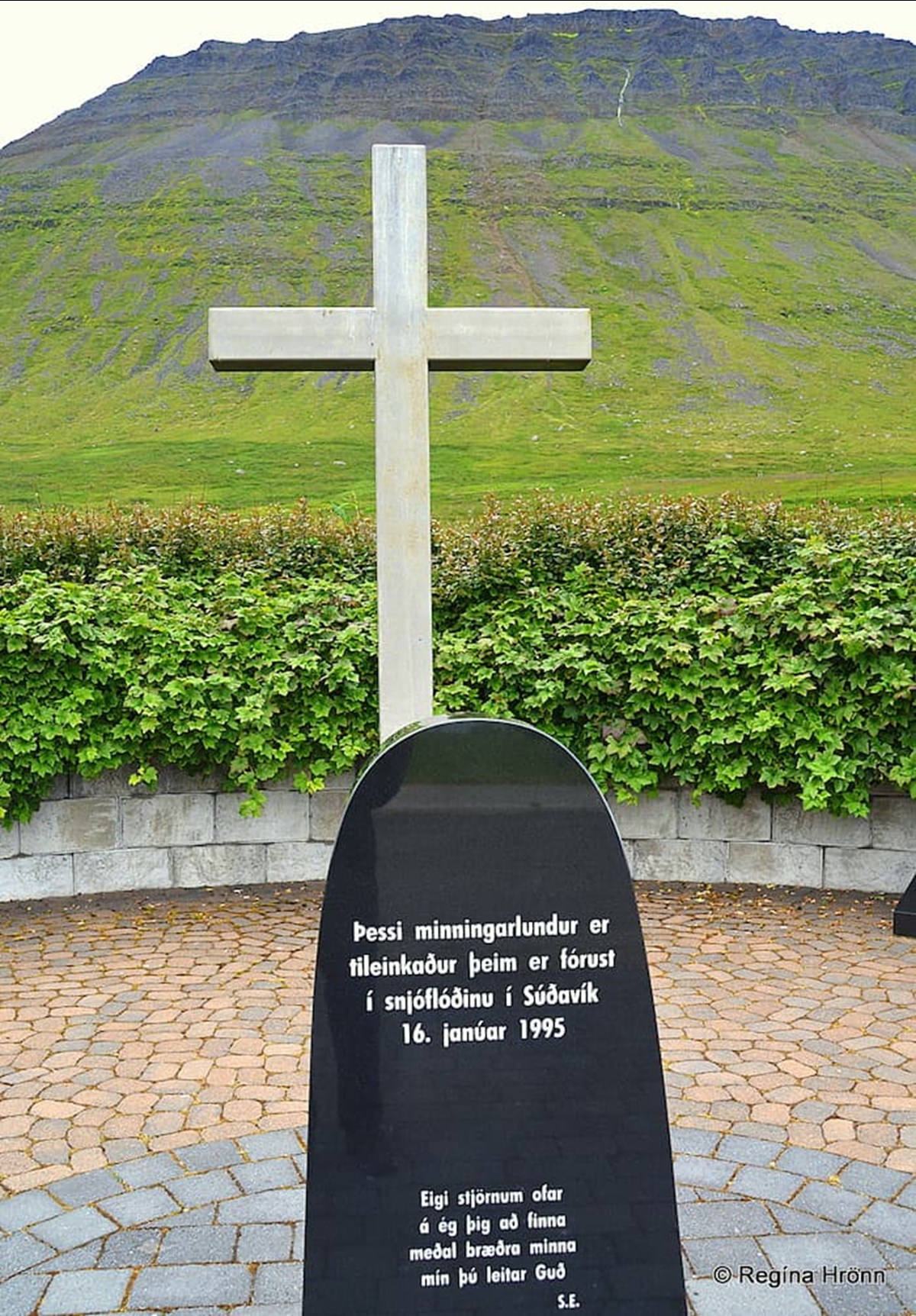
The memorial grove for the victims of avalanches in Súðavík
Súðavík has had its share of tragedies, and close to Raggagaður park, you will find the memorial grove for the people who lost their lives in the dreadful avalanche in 1995. This big avalanche came rushing down the mountain on the 16th of January 1995.
I remember it well as the whole nation was in shock watching the news, waiting for people buried under the masses of snow to be found, and the Icelandic nation was united in praying for them to be alive and helping in any way we could.
14 people got killed when the avalanche hit 15 houses, thereof 8 children. 3 of these children belonged to the same family, and the whole nation grieved for the loss. Their father of the 3 children, Hafsteinn Númason, was at sea at the time of the avalanche and heard about the avalanche on the news :(
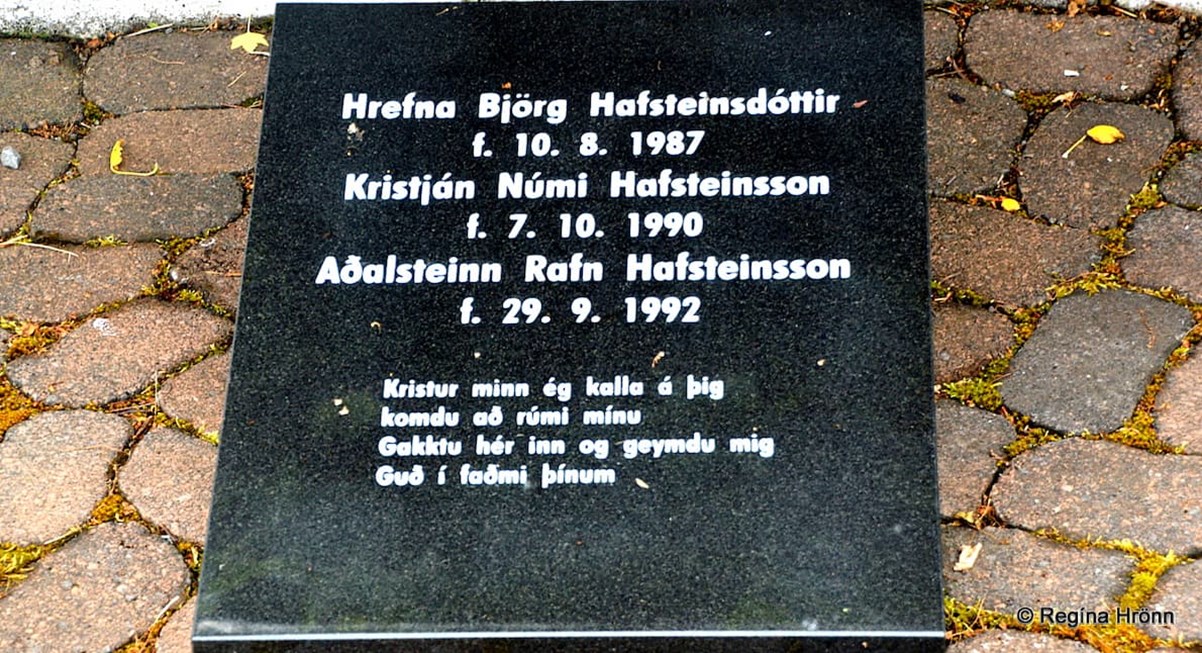
The memorial grove for the victims of avalanches in Súðavík
And later he saw on the news that his children, age 7, 4, and 2 had been killed in the avalanche :( Utterly, utterly heartbreaking. I cannot even write about this without getting a lump in my throat, even though so many years have passed since the avalanche happened.
Snow, even though it can be so beautiful, can be so unforgiving.
Hafsteinn and his wife moved to Reykjavík and their children are buried in Gufuneskirkjugarður cemetery. I used to live close by and always visited the grave of the children when I was walking through the cemetery to show my respect.
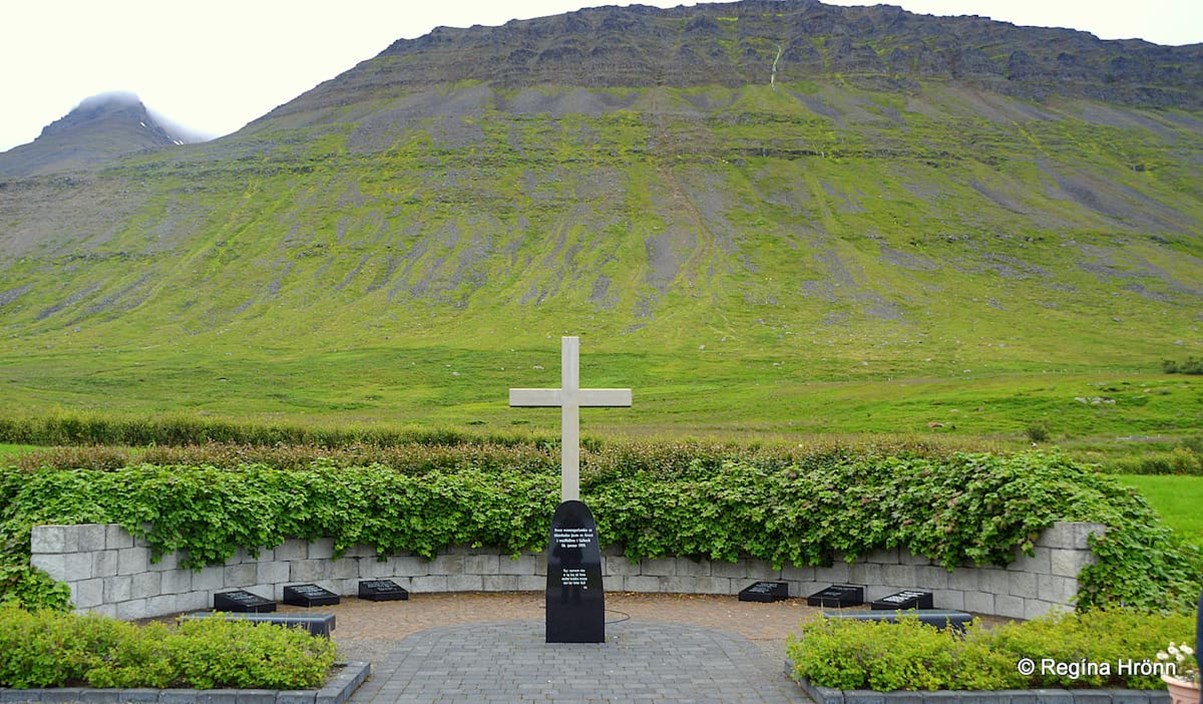
The memorial grove
A memorial grove has been erected in Súðavík in remembrance of the people who got killed in this avalanche in 1995.
Since the avalanche, the Súðavík village has been divided into two parts.
In order to protect the villagers from another such awful tragedy, the newer part of the village was built at a safe distance from the mountain. The old part is now a summer resort.
Súðavíkurkirkja church and the Memorial for drowned fishermen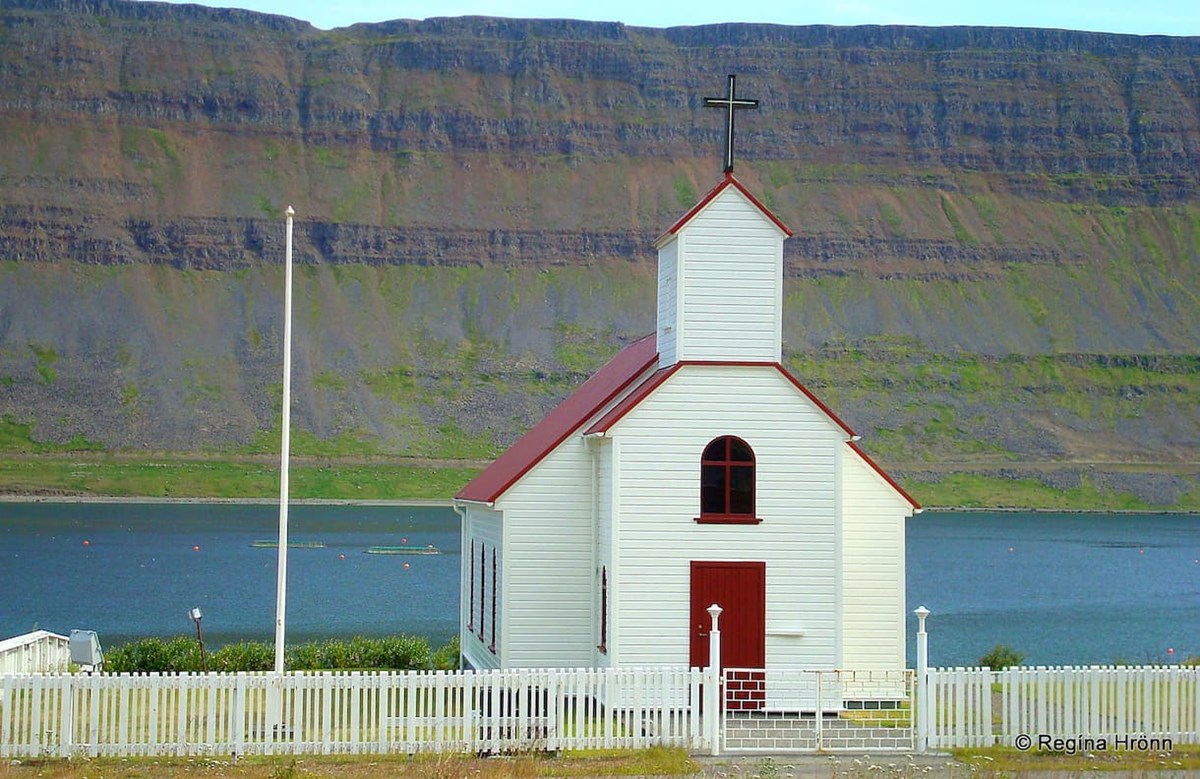
Súðavíkurkirkja church in Súðavík
You will notice a church by the road - Súðavíkurkirkja church. It was moved to Súðavík from Hesteyri in Hornstrandir.
The church was originally built in 1899, a present from the Norwegian Brödrene Bull to the inhabitants of Hesteyri. Brödrene Bull had erected a whaling station at Stekkseyri.
When that area became deserted the church was moved across Djúpið to Súðavík and was consecrated here in 1963. This move caused quite a stir.
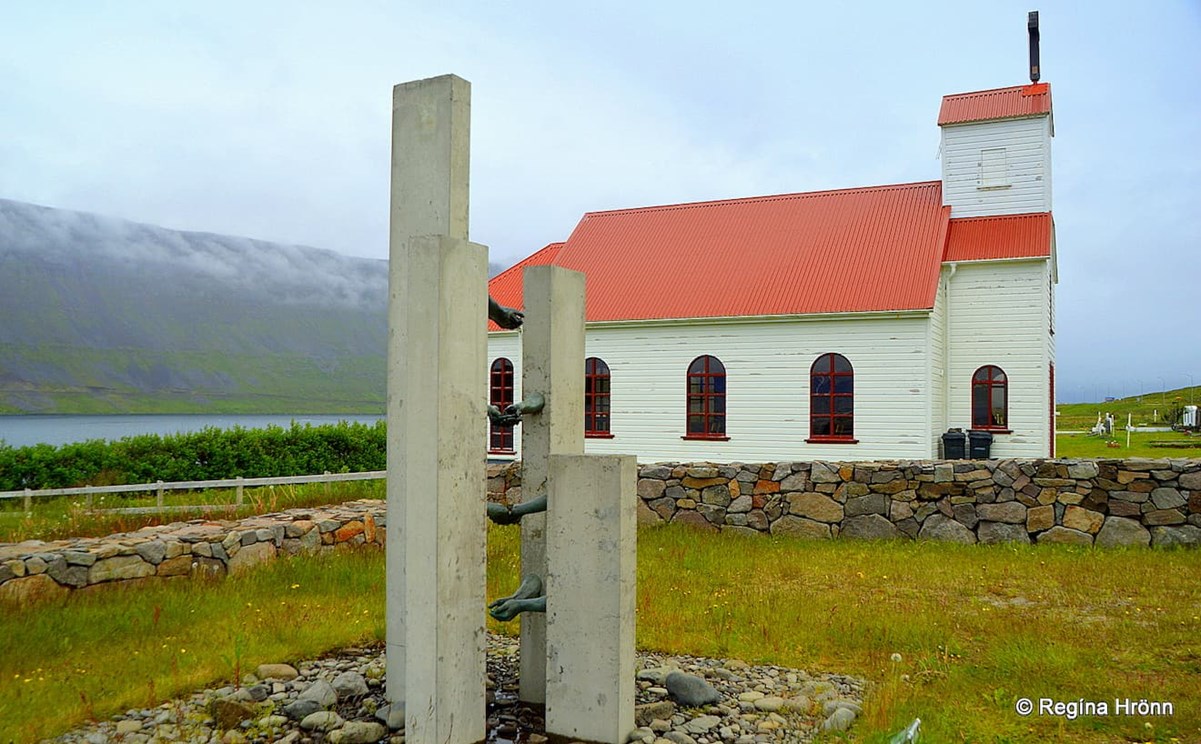
Súðavíkurkirkja church in Súðavík and the Memorial for drowned fishermen
The church was closed and I didn't know whom to talk to to get the key.
As I have already told you in my travel-blogs then I visit all the churches I encounter on my travels around my country and had just come from visiting Eyrarkirkja in Seyðisfjörður close by, which was also closed.
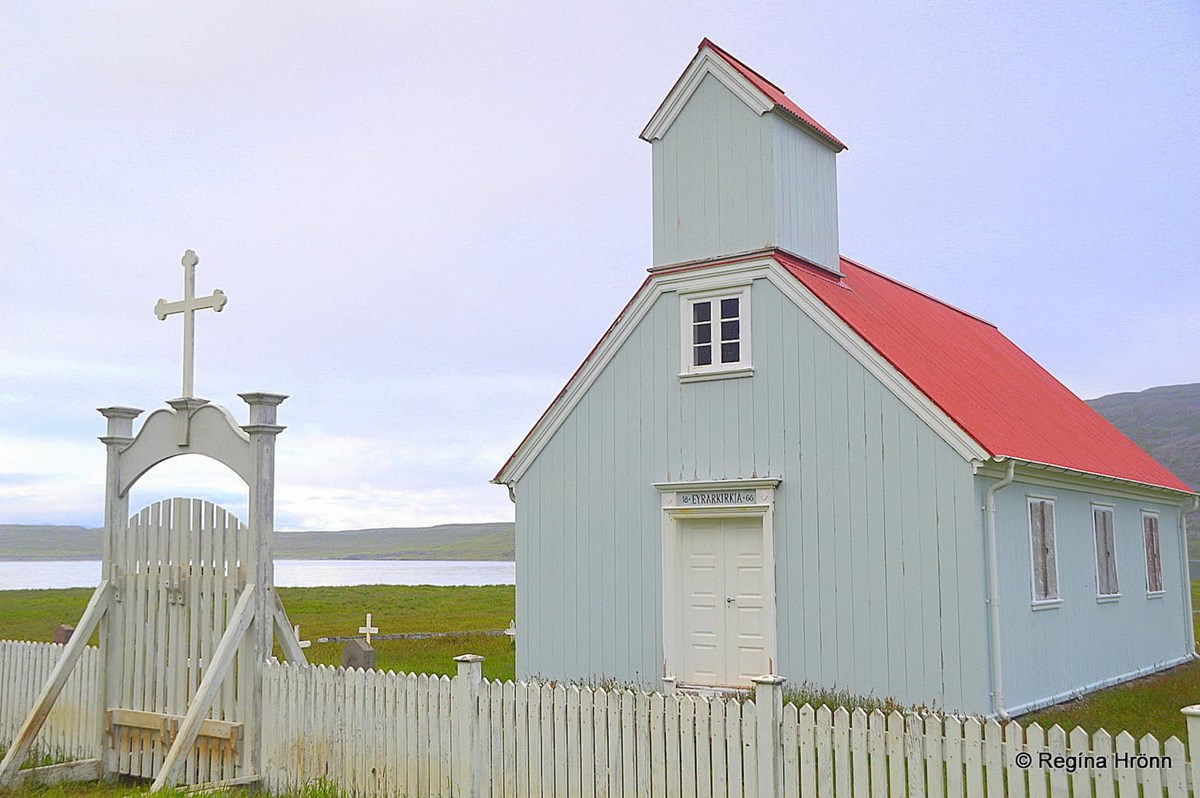
Eyrarkirkja church in Seyðisfjörður fjord
Next to the church, you will see the "Minnisvarði um drukknaða sjómenn á Súðavík" - the memorial for drowned fishermen in Súðavík, erected in 2010.
It is a beautiful memorial, as these memorials always are, beautiful works of art.
I always look for and visit these memorials in every town and village by the sea during my travels in my country.
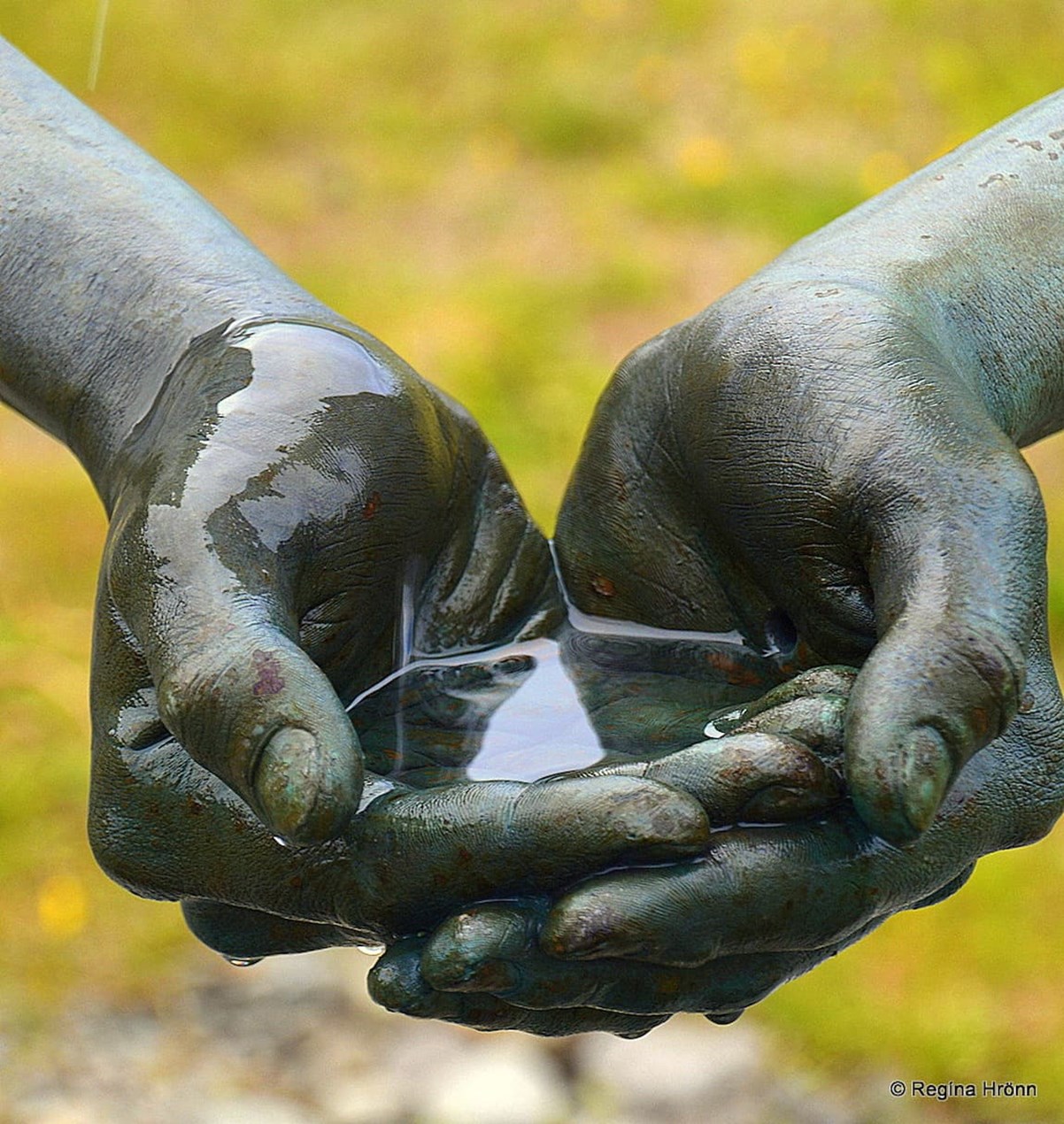
The memorial for drowned fishermen in Súðavík
I consider these memorials to be the heart of the villages of Iceland.
Langeyri and the Guesthouse Swanfjord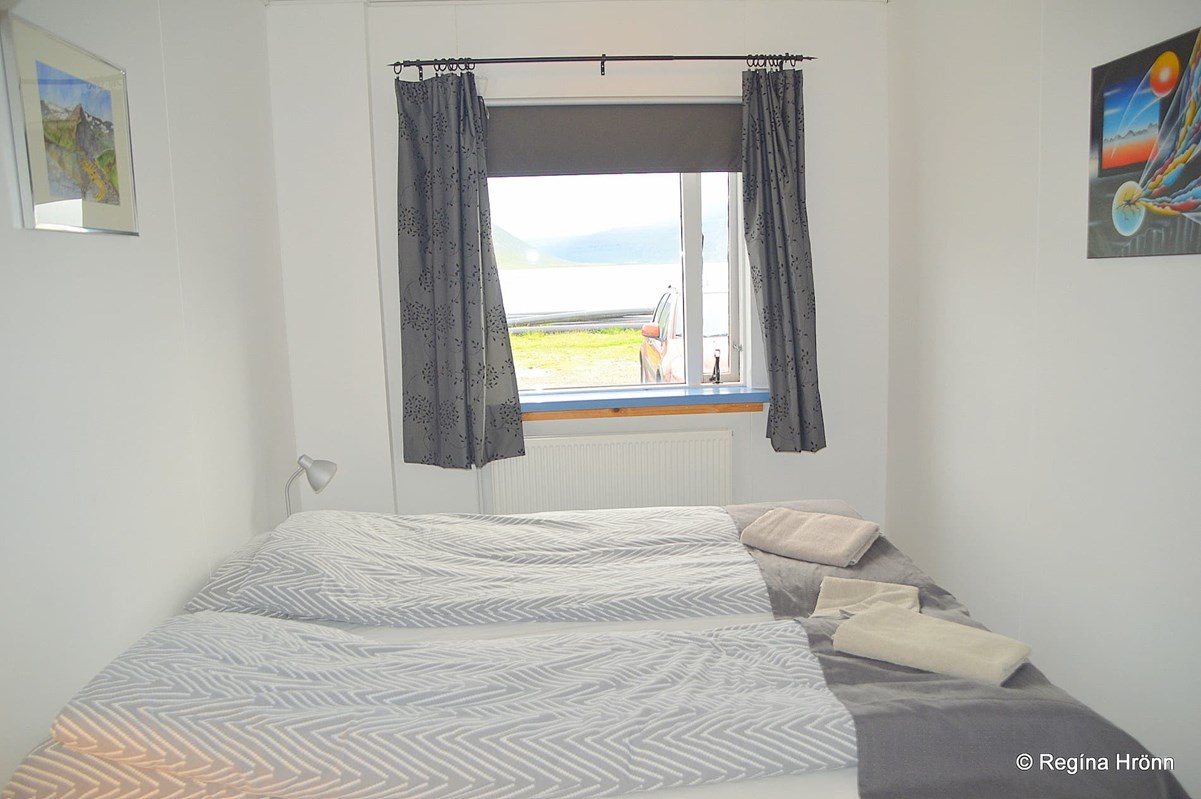
Our room at Guesthouse Swanfjord at Langeyri
We stayed for the night at Guesthouse Swanfjord at Langeyri just outside of Súðavík.
The guesthouse is in a lovely location, right by the sea in Álftafjörður fjord - the Swanfjord.
The guesthouse is in an old, converted fish warehouse, lovely decorated with a community kitchen and sitting area. 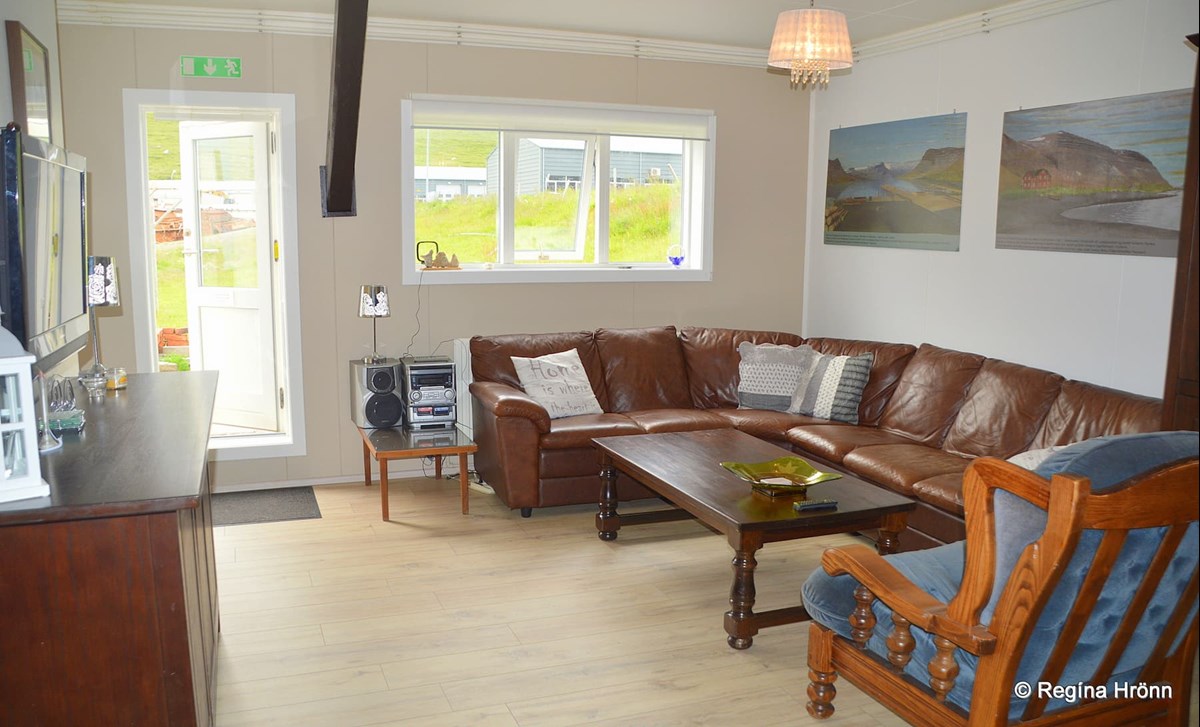
The sitting room at the Guesthouse Swanfjord at Langeyri
Langeyri is a great place for birdwatching. I stayed for the longest time by the sea just taking in the beauty.
The bright summer night at Langeyri was so serene that I had to take a video to watch during the dark winter months in Iceland.
Midway through the video though, I was abruptly interrupted as the cranky Arctic tern attacked me.
This cranky bird doesn't seem to be able to leave me alone in the summertime in Iceland. It flies over to Iceland to breed all the way from South Africa.
And we, the inhabitants of Iceland, who live here all year round, are in its way and it fearlessly attacks us.
I know it is only protecting its young ones, but it also attacks me when I am not even close to the nests, so it is a big nuisance and keeps me from visiting all the places I want to see on my travels in Iceland.
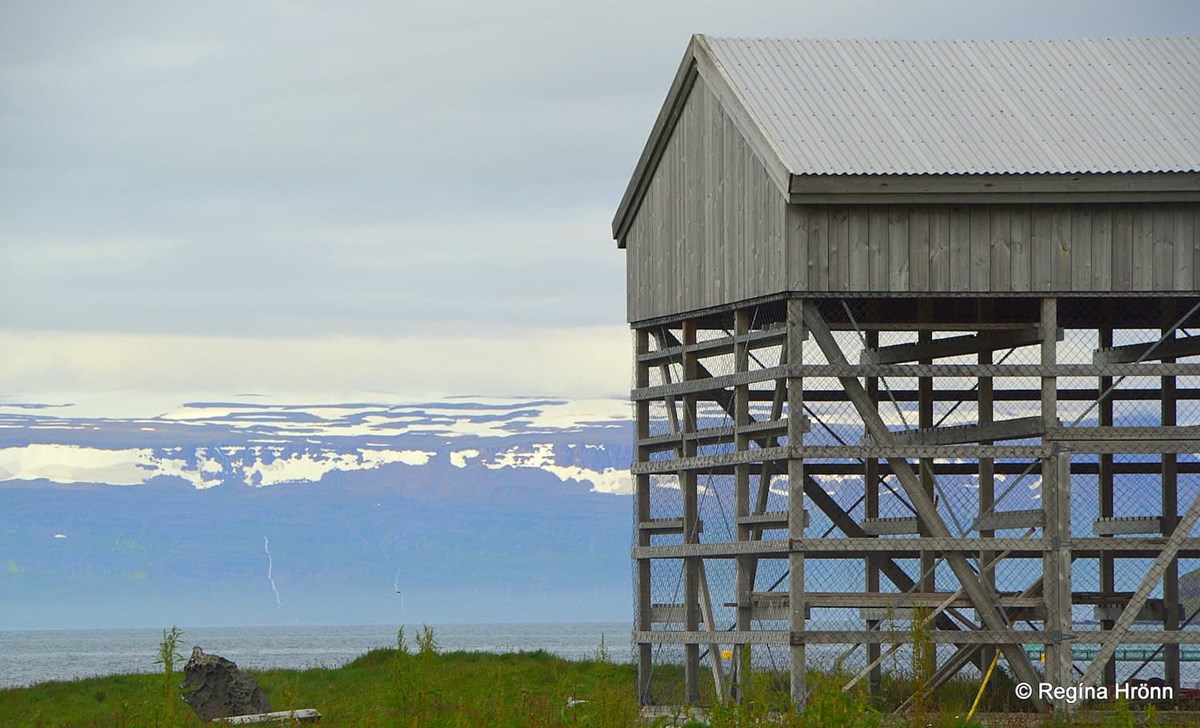
Langeyri in the Westfjords of Iceland
While travelling in the Strandir area, the easternmost part of the Westfjord region, we met a car with tourists.
They were so distracted by the many Arctic terns that they drove straight off the road at full speed.
Thankfully they drove off the road instead of crashing into our car. So be aware of the Arctic tern!
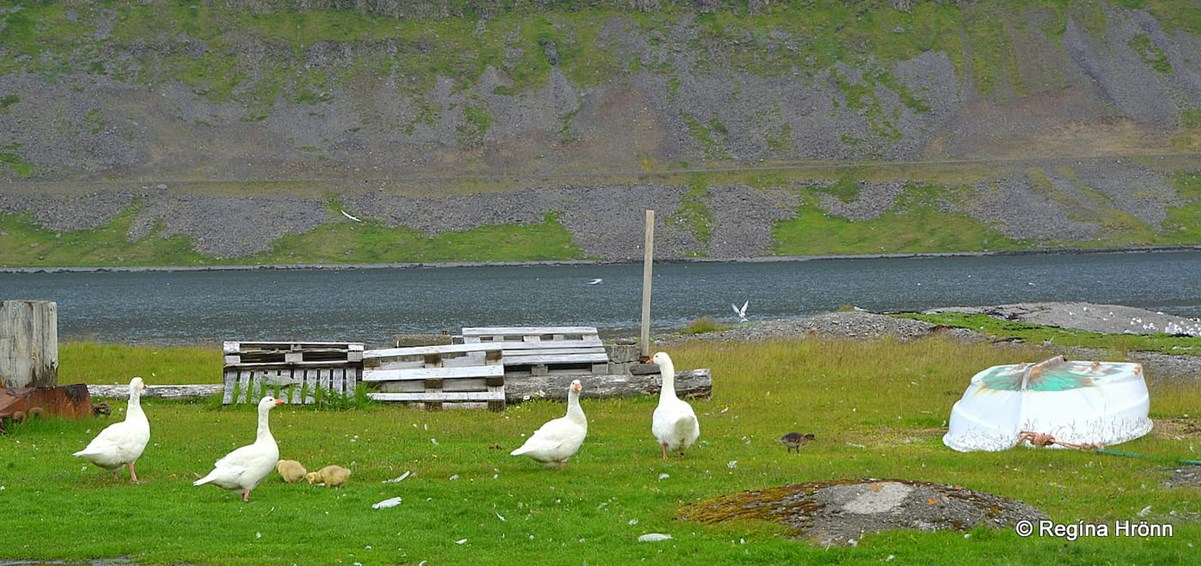
Langeyri in the Westfjords of Iceland
Here at Langeyri was the main Hanseatic station in the 15th and 16h century, where the German Hanseatic merchants would trade with the fishermen.
And here at Langeyri the Norwegian whaling station, Alpta Hvalstation, was erected back in 1883 (Mbl.is).
The Norwegians erected several whaling stations in the vicinity and almost emptied the fjords of whales, so they left this area after about 20 years.
Later on, Icelanders ran a fish processing factory at Langeyri. So it wasn't always as serene here at Langeyri as it was when I visited.
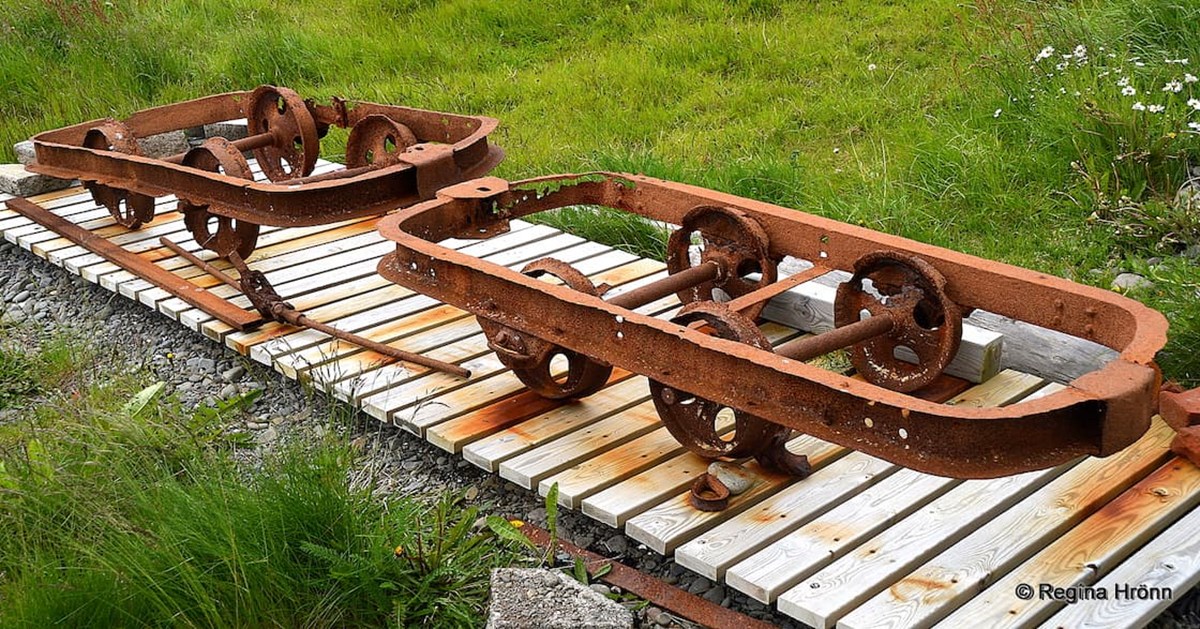
Langeyri in the Westfjords of Iceland
We had a lovely time in Álftafjörður - I always try to stay for the night in villages around Iceland to get to know them better. And I am glad that I chose Langeyri as the bright, serene night by the sea was one of the highlights of my Westfjord trip.
The following night we stayed in Ísafjörður, the capital city of the Westfjords, which is only 20 km away from Súðavík. On that day we went on a guided tour of Ísafjörður, went kayaking, and also explored the surrounding fjords.

Arnardalshamar (Arnarneshamar) tunnel
To reach the next fjord, Skutulsfjörður fjord, by which Ísafjörður town stands, we drove through the oldest tunnel in Iceland.
Arnardalshamar is a basalt dyke between Ísafjörður town and Súðavík village, and it was no easy task drilling this hole back then and took quite some time and effort.
This tunnel was ready in December 1948 and taken into use in 1949 when the road was ready on the Súðavík side of Arnardalshamar (Arnarneshamar).
The tunnel is approx. 30 m long and in 1995 the tunnel was enlarged and is now almost double as wide as it used to be at 8.5 m. 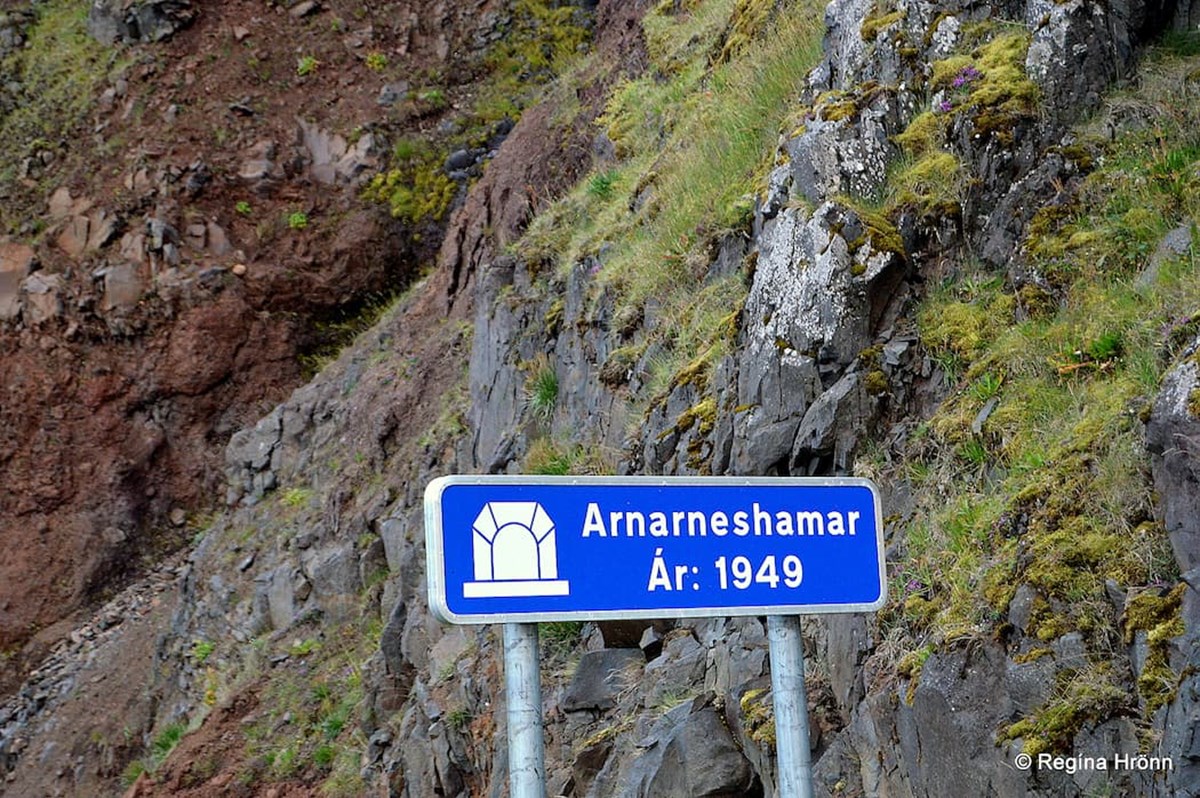
Arnarneshamar sign by the tunnel, which I prefer to refer to as Arnardalshamar
So for 46 years, the tunnel was a one-lane tunnel, and the locals would honk their horns prior to entering the tunnel to warn cars coming from the opposite direction that the tunnel was occupied. The locals nicknamed the tunnel Hamarsgatið or the Hole in the Cliff.
I will tell you more in my next travel-blog about Ísafjörður - A Delightful Visit to Ísafjörður - the Capital City of the Westfjords.
Here is the location of Súðavík and Álftafjörður on Google maps.
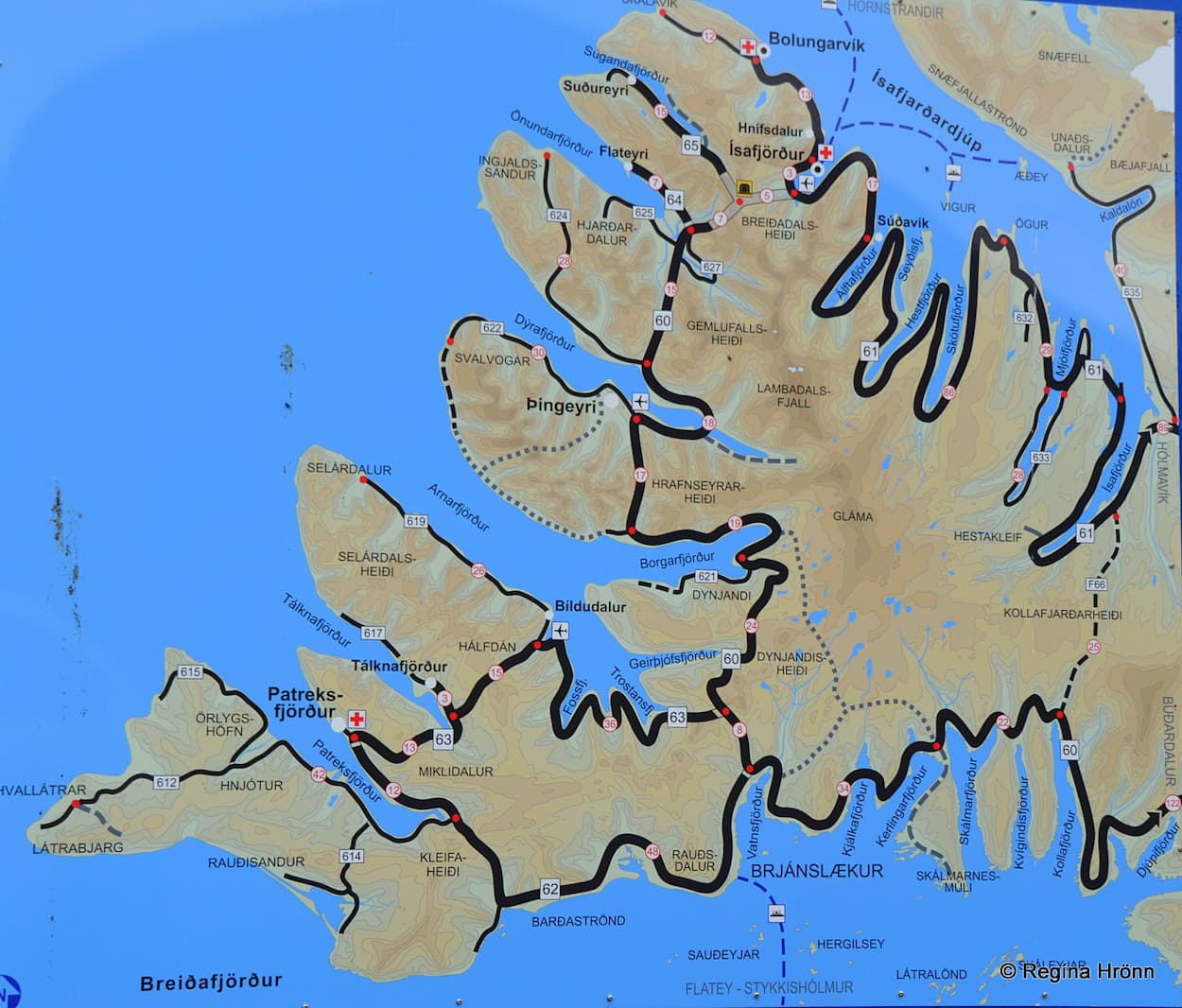
The map of the Westfjords
The travel-blogs I have written in chronological order about the northern part of the Westfjords are:
A lovely Visit to Reykjanes in the Westfjords
Vatnsfjörður in the Westfjords - the Viking Estate and Grettisvarða Cairn
Litlibær Turf House on the Hvítanes Peninsula in the Westfjords - a Cute little Turf House Café
Watching the cute Seals at Hvítanes Peninsula in the Westfjords
Visiting Súðavík Village and Langeyri in Álftafjörður in the Westfjords
A Delightful Visit to Ísafjörður - the Capital City of the Westfjords
Hnífsdalur village in the Westfjords and the big Avalanche in 1910
Visiting Bolungarvík Village - the End of Road 61
Have a lovely time in the wonderful Westfjords of Iceland :)
